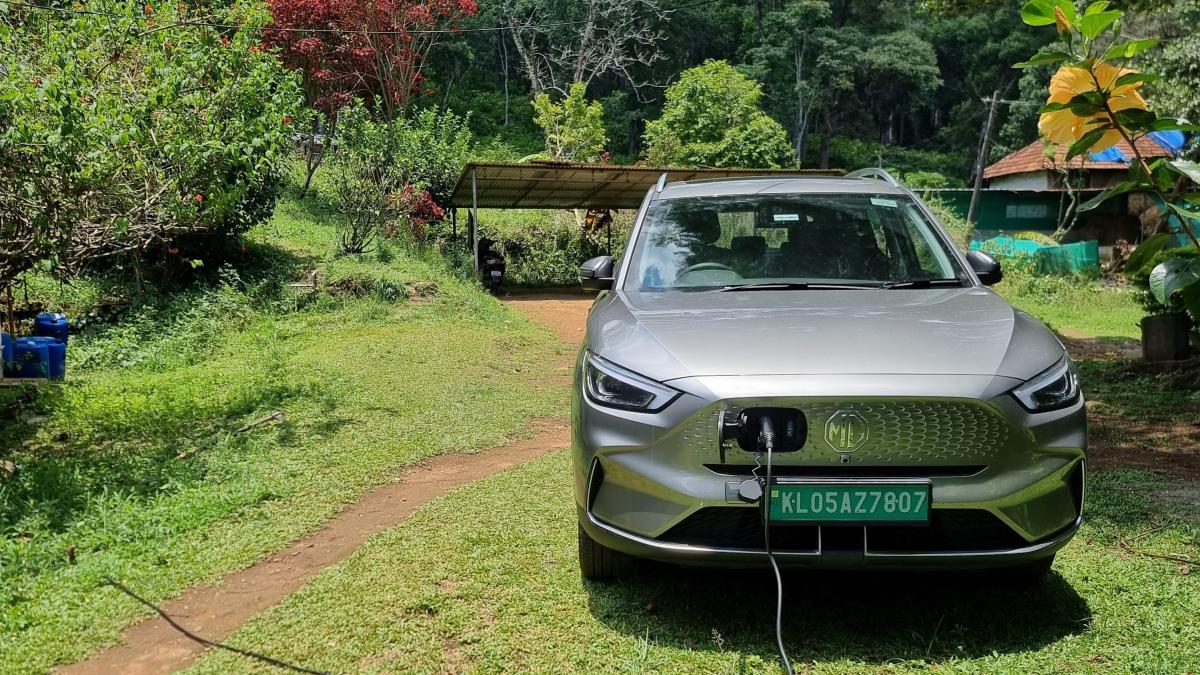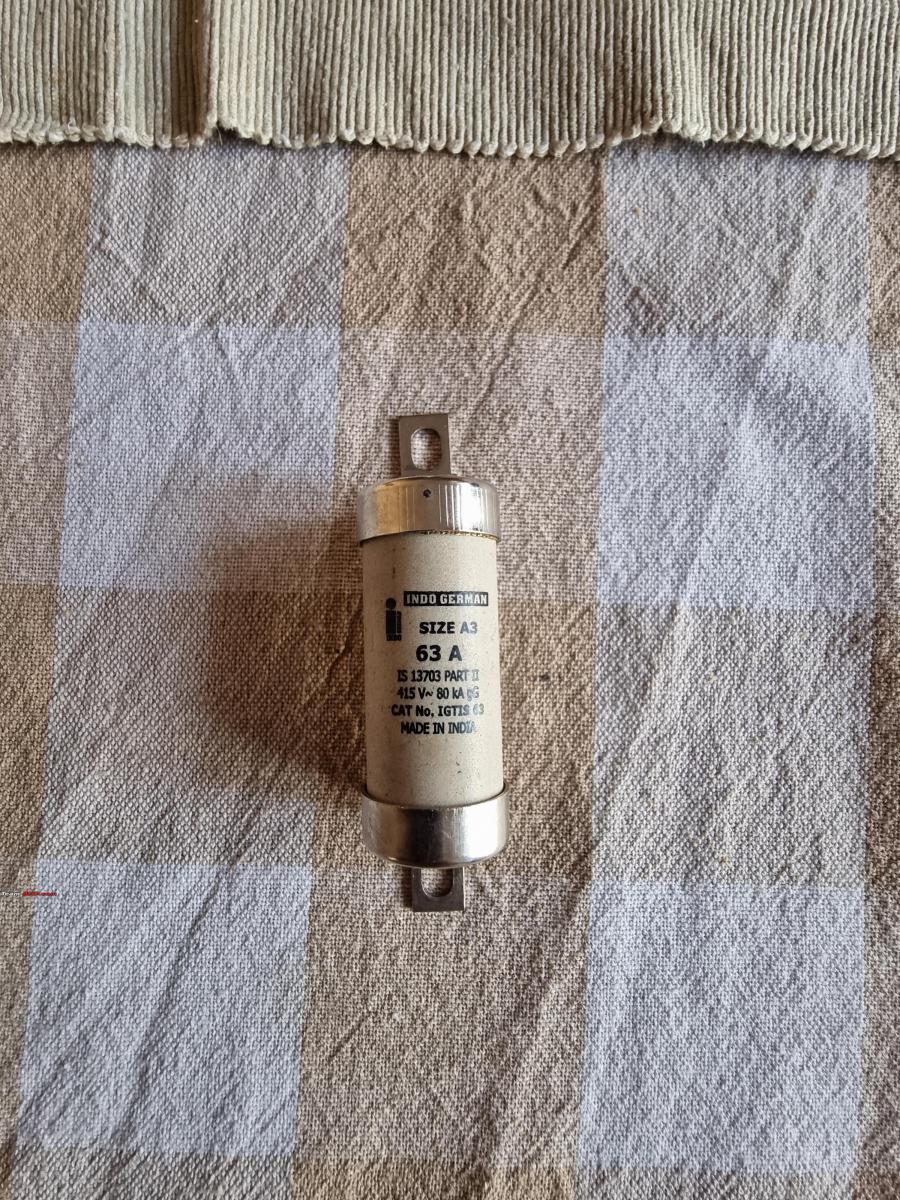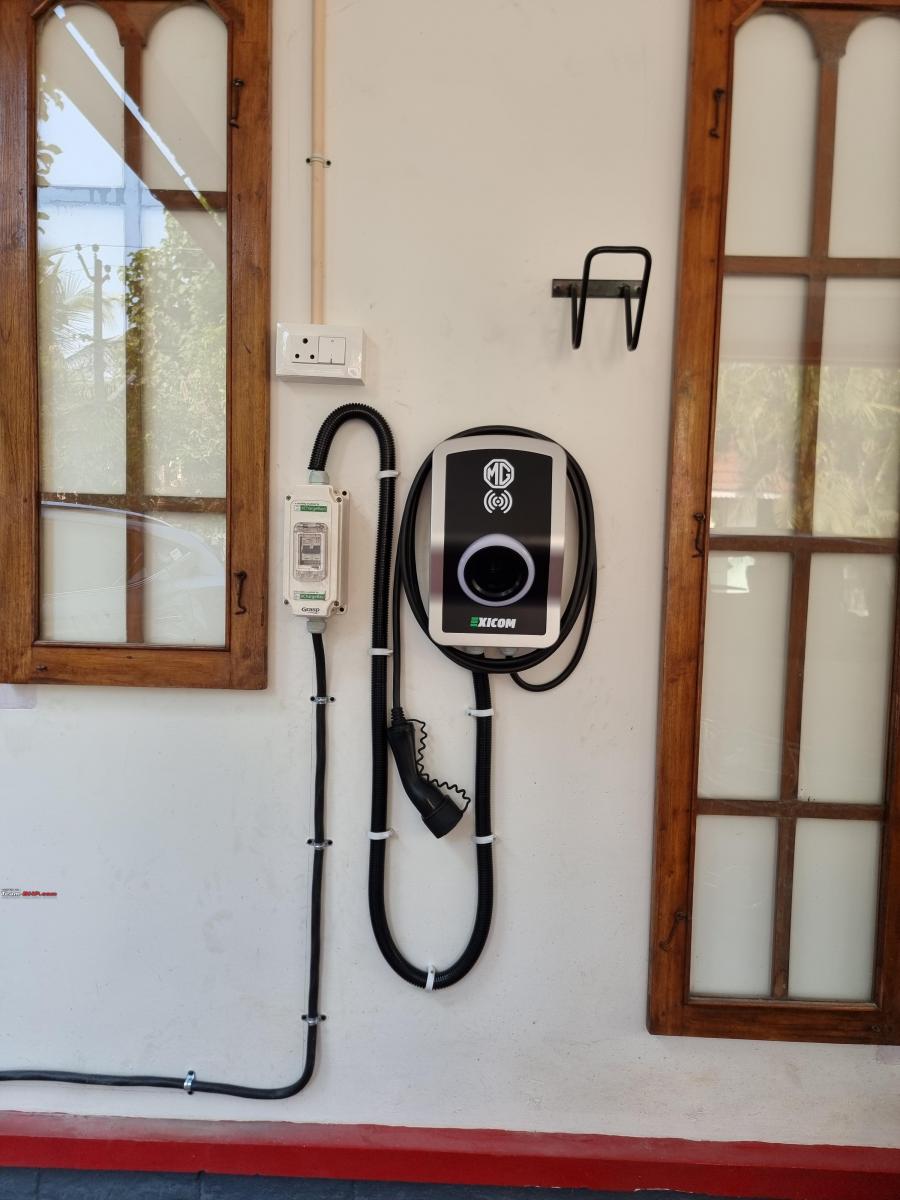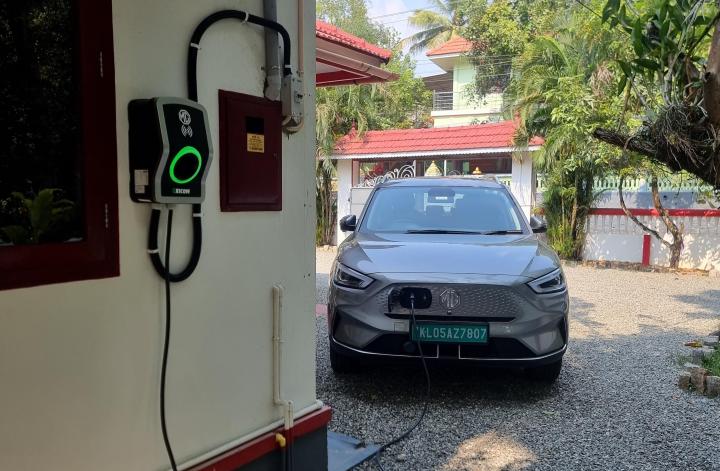News
Set up fast-charging at home for my new MG ZS EV: Detailed guide + pics
The overseer from the Kerala State Electrical Board (KSEB) came for inspection and ensured all the requirements were met to get the fast charger installed.
BHPian sushanthys recently shared this with other enthusiasts.

Note: This is partly a technical post with a lot of electric jargon. I have tried to keep it as simple and interesting as possible.
Hi TeamBHPians,
I recently became part of the EV evolution/revolution by purchasing an MG ZS EV.
There are a lot of articles about EV cars, merits/demerits, ownership reviews etc. I will be writing on something else, an often ignored topic when purchasing an electric car – how to upgrade your electrical infrastructure at home so as to make EV ownership, a seamless affair.
We started the car-buying process in the early days of February 2023. Test drove the Tata Nexon EV, MG ZS EV and the Honda City e:HEV. Both Nexon EV and the Honda eHEV were nice cars. Having owned a Honda Jazz for 8 years, we wanted to give another car a try (The Honda City eHEV is a very good car and we may consider it in the future. The only things we did not like were the tinny horn, the small boot and the cycle tyre like a spare tyre). Between Nexon EV and MG ZS EV, the latter was clearly the winner (more range and an all-around better car). So, we finalized our decision and booked the MG ZS EV by February midst. Due to increasing demand, MG is giving priority to its ZS EV cars and the waiting time has come down drastically. We were allotted the car within one week of booking.
MG gives a 7.2 Kw charger free of cost along with its car. Installation is also free (although our story ended up somewhat different). Currently, all-electric car companies install the wall charger free of cost although that may change in the future (Tesla has already started the trend of stopping the provision of free chargers and installation).
The Requirements
I stay in Kottayam, Kerala and the installation process which I will describe below is applicable to Kerala. The story may be the same or different in other states.
MG has outsourced the charger installation to a private company. They are called Echargebays Emobility Solutions Pvt Ltd. They actually handle the charger installation of all-electric car models in Kerala at present (including Tata, Volvo and Mercedes Benz).
Anyway, one week after our car allotment, we got a call from Echargebays. They wanted to do a site inspection before they proceeded with the wall charger installation. Due to work commitments on both sides, the inspection happened 3 days later, on a Thursday.
They examined the house and the proposed site of my charger. After inspection, they told me that the electricity supply to my house needed to be upgraded.
For basic information, for electric car charger installation at home, you need to have a 3-phase connection. If your electricity load is above 5 kW (5000 W), the supply will automatically be 3 phases. My house already had a connected load of 7.5 Kw and had 3 phase connection. So the basic criteria had been fulfilled.
The Echargebays guys asked the following things to be done.
The KSEB Service line from the electric post to the energy meter should be changed to 16 sq mm Aluminium (It was currently 10 sq mm Copper wire).
The energy meter fuses are to be changed from 32A to 63A capacity. They recommended the installation of HRC (High Rupturing Capacity) Fuses. These have a higher threshold to withstand electric surges and are safer.


The outgoing cables from the Energy meter to the fuse should be changed to 10 sq mm Copper cable.

The electricity load is to be enhanced by 8 kW (The electricity load has to be enhanced by the power of the charger. Hyundai provides an 11kW charger whereas Mercedes Benz provides a 22kW charger with their cars. In such cases, the load will have to be enhanced by 11kW and 22kW respectively.)
The above work was under the scope of the Kerala State Electricity Board (KSEB) for which I would have to visit the KSEB office.
The Echargebays guys also wanted a Miniature Circuit Breaker (MCB) to be installed by an electrician, to which the wall charger would be connected. Only after all these things were done would the charger be installed.


KSEB Work
I went the same evening to the KSEB Office at Ettumanoor. The guys at the reception had no idea about the requirements. They asked me to go meet the overseer. The overseer was a man known to me and thankfully knew the details. He told me the necessary documents required for the application.
- Application form costing Rs.10. This is a common form for application for connection/load enhancement with no mention in the form anywhere about electric cars.
- Aadhar card copy
- Land Tax Receipt/ Land Ownership certificate
- Wiring diagram of the house
Once all these were submitted, the overseer agreed to come for an inspection.
The first 3 were easy. The form was sort of archaic but not difficult to fill.
The wiring diagram needed an electrician’s service. Now electricians, as many of you may know, are not easy to get hold of. They are busy people and need multiple reminders. Anyway, by necessity, I had access to multiple electricians and one of them came the next day for the diagram.
The wiring diagram is an official document and needs a licensed electrician’s signature and seal. Thankfully, our electrician gave me the wiring diagram on Monday (20th February). He charged Rs.500 for his services.
The connected load at our house came to around 9.5 Kw. The electrician had however used old values (for eg, an old fan is rated at 70w but the new BLDC fans need only 28W; Likewise for conventional tube light Vs LED Tube lights). So, the actual load was actually around 8.5 kW only (You can be penalized by KSEB if your actual load is more than the connected load, but here since I had given the application for enhancement, it was not an issue).
The documents, along with a paper file, were submitted to the KSEB Office on the same day. KSEB charged me Rs. 189 for the paperwork and subsequent inspection. I got an SMS saying that the inspection would be done within one week. I met the overseer at the office and he agreed to come within 2 days.
Government Offices and Officers operate at their own pace. The overseer came finally after 3 days on a Thursday (23rd February). He did the inspection and gave me the required list of things. I was to buy the cables and the fuses and they would change the wiring.
I bought the required stuff the same day. The total amount came to around Rs.6687.
Meanwhile, the car had reached the stockyard. We inspected the car and did a PDI. Everything looked good. The delivery date was fixed for March 2nd (Thursday). So, we had exactly one week to set up charging infrastructure at our home.
Of course, things as usual did not go according to plan.
The overseer had to file his report at the KSEB Office. He filed it on Monday and asked me to come and pay the amount on Tuesday. I went on Tuesday (28th February) to the office to find that the report had still not been filed. Thankfully, the overseer had come into the office just then and finished his work promptly. The fees for enhancing the load came to Rs.18,388. Paid the amount in cash (No UPI/POS Machines available). I requested the overseer to finish the installation work the next day, which he promised to do.
Meanwhile, the MG guys were in contact regarding the delivery process. During our conversations, they suggested installing a 15A power plug in the car porch as slow charging is the accepted mode of charging an EV. I decided to get that done as well as the electrician will be coming anyway.
On Wednesday (1st March- the day prior to the car delivery), the KSEB installation guys came in the afternoon. They changed the old distribution wire and the fuses and connections. It took around 2 hours but they did a very good job. The KSEB part of the work was over.

Ours is an 18-year-old house with the wiring of that time. In newer houses where provision is already there for EV Charging, KSEB may ask to proceed with charger installation and then come for inspection regarding load enhancement, once the work is complete. But for us, things transpired this way.
The next step was installing a 2-pole 40A MCB. The connection from the fuse had to be with a 10 sq mm Copper wire. The MCB should also be properly earthed using a 10 sq mm Copper cable, near the meter panel. The earthing is to make sure that the neutral earth voltage would be less than 3V (Ideally zero Volts) without which the AC fast charger would not function.
This was to be done by the electrician who had already been informed. Unfortunately, he had come down with toothache and would not be available for the next 2 days.
I called up the MG guys and told them to charge the car 100% before handing it over to us. They agreed.
On 2nd March, Thursday, our family became the proud owners of an Aurora Silver MG ZS EV.
There is no point in keeping a brand-new car confined to the garage. We went for many drives in the next 3 days. Driving an EV is one hell of an experience. The EV owners will know what I’m talking about.
By next Monday, the car’s charge was at 26%. There is a DC fast charger 3 km from our home but I wanted to use it only if absolutely necessary. Our electrician finally came on Monday afternoon. He inspected the site, bought the necessary things and installed the MCB with proper earthing.

He also installed a 25A plug point on our porch. The connection for the plug point was taken directly from the energy meter with thick 10 sq mm Copper cables. Care should be taken to avoid connecting it to the Invertor supply for obvious reasons (The Invertor will not be able to take the heavy electric load).

The quality of work was very good. The expenditure came to around Rs.6000.
We did our first home charging that night. Charged for 12 hours. The charging rate is 4% per hour. The charge was at 75% the next morning.
I informed the Echargebays people and they came on Wednesday (6 days after I bought the car). The home charger comes along with the car and is from a company called EXICOM (They also supply the home charger for Volvo electric cars). The charger is quite bulky and you generally don’t see pictures of it during the period of car purchase. However, it was bigger than expected.
The installation took around 2 hours. They used a POLYCAB XLPE (Cross-Linked Poly Ethylene) cable (costs Rs.450/m) for connecting the charger to the MCB. They did a good job.
The guys who came for installation were from a different team from those who came for the survey. I had told my specifications for installation but somehow the installation team went strictly by company policy. I had wanted the wiring to be taken near the ceiling so that it would be out of sight but the installation team finally took it just above the basement level citing company policy and the presence of a CCTV camera nearby (High voltage can result in blurring of CCTV images). The resultant picture was a bit of an eyesore to me.


The guys checked the MCB neutral voltage and found that it was 9V. They couldn’t activate the charger as the neutral voltage had to be less than 3V. They said that the only way to reduce the Neutral voltage is to do earthing of the electric post which supplies power to us (Trivia – If earthing of the electric post also does not bring down the neutral voltage, then the transformer which supplies the electric post will need adequate earthing). These matters were again under the purview of KSEB and I was sort of back to square one. The charging guys asked me to call them once the neutral voltage was sorted out and left.
My better half came home a little later. She looked at the new setup and was aghast. I couldn’t really blame her since it was not exactly a pleasing sight. There was only one option left – to change the position of the charger.
Our installation required around 7 m of XLPE Cable. The Echargebays guys had told me a rather interesting fact. When you sell an electric car, the length of the charger cable is taken into account. If you have a short XLPE cable, your car’s resale price can come down as the new owner will be charged for the extra cable length.
But despite this, we were not happy with the charger position. So the next morning, I called up Echargebays and requested them to shift the charger to another spot where it will be much less obtrusive.

Now came the hitch. They said that since they had already reported to the company that the installation was done, they were powerless to do any modifications. They asked me to send a mail to MG India. I called up the dealership and they talked with Echargebays. Echargebays finally agreed to reinstall the charger but charged me a hefty Rs.5900, citing outstation work. I paid up since there was nothing else to do.
Meanwhile, I informed the overseer about the neutral voltage. After 2 days, he sent a team from KSEB. They came ready to do the earthing (Earthing the electric post is done with a two-and-a-half-inch long GI Pipe. I don’t know the details since they did not do it at the end). They first examined the Distribution Box (DB) inside our house and adjusted the phase switches. When they checked the neutral voltage, it was 0 Volts. Turned out that the problem was with the switchboard. The electric post did not need earthing after all. They informed me and left.
I messaged Echargebays regarding the development. They agreed to come within 2 days. But it was the end of the financial year and they had many installations to do. They finally came on 30th March (Thursday).
Continue reading BHPian sushanthys's home charging guide for more insights and information.


















